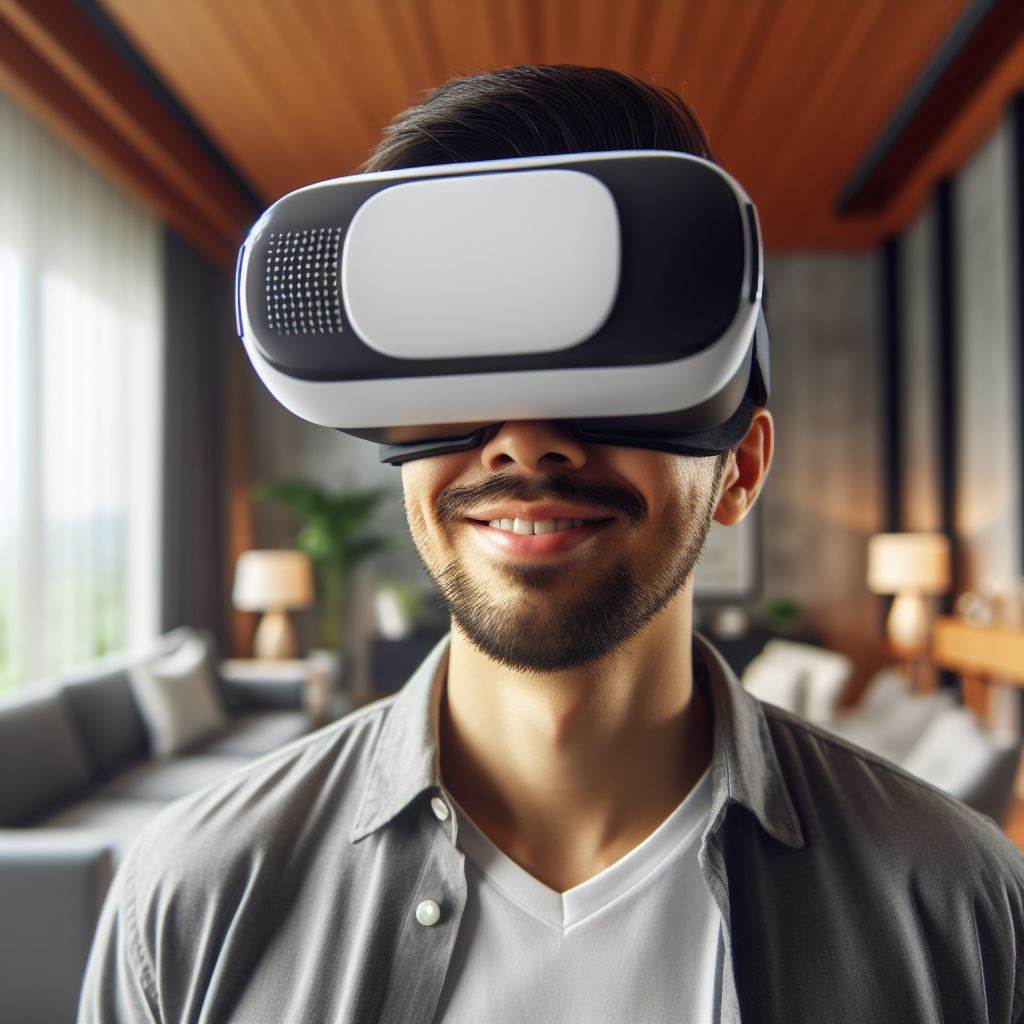Introduction
The real estate industry is constantly evolving, and one of the latest trends that has revolutionized the way properties are marketed is virtual tours.
Gone are the days when potential buyers had to rely solely on static images and descriptions to envision a property.
In today’s digital era, virtual tours have become an essential tool in the real estate industry.
Virtual tours offer a unique and immersive experience for potential buyers, allowing them to explore properties from the comfort of their own homes.
With the rise of technologies such as 3D imaging, video walkthroughs, and augmented reality, virtual tours have become incredibly realistic and interactive.
Buyers can now get a true sense of the property’s layout, size, and features before deciding to visit in person.
In recent years, the popularity of virtual tours has skyrocketed.
This can be attributed to various factors, including the increasing accessibility of virtual tour software and the growing demand for convenient and efficient ways to view properties.
Additionally, the ongoing COVID-19 pandemic has accelerated the adoption of virtual tours as a safer alternative to traditional in-person viewings.
Looking ahead to 2024, virtual tours are projected to play an even more prominent role in the real estate industry.
With advancements in virtual reality and artificial intelligence, virtual tours will become even more immersive and customizable.
Buyers will be able to personalize their virtual tour experience, allowing them to envision themselves living in the property.
In essence, virtual tours have become vital in the real estate industry, providing an unparalleled experience for potential buyers.
As technology continues to advance, virtual tours will continue to rise in popularity and significance, ultimately driving sales in 2024 and beyond.
Real estate professionals must embrace this trend to stay ahead in a competitive market.
Evolution of Virtual Tours
A. Historical background of virtual tours in real estate
Virtual tours have become an essential tool in the real estate industry, revolutionizing the way properties are presented and viewed.
Although virtual tours have gained popularity in recent years, their beginnings can be traced back to the early 1990s.
In the past, potential buyers had to rely solely on photographs and descriptions provided by real estate agents or brochures to get an idea of a property’s layout and features.
This often left them with a limited understanding and required them to physically visit each property, which was time-consuming and inconvenient.
The early versions of virtual tours were simple slideshow presentations or panoramic images that allowed viewers to see a series of static images.
These virtual tours were typically displayed on CDs or DVDs and required specific software to run.
Although they were a step forward from photographs, they still lacked the immersive experience that modern virtual tours offer.
B. Advancements in technology that facilitated the growth of virtual tours
Advancements in technology have been instrumental in the growth and widespread adoption of virtual tours in the real estate industry.
With the increasing popularity of the internet and the development of more powerful computers and smartphones, virtual tours have evolved into highly interactive and immersive experiences.
One of the key technologies that facilitated the growth of virtual tours is 360-degree photography.
With the advent of affordable and high-quality 360-degree cameras, real estate agents and photographers could capture a property’s every angle and create a virtual environment that allows viewers to navigate and explore as if they were physically there.
Furthermore, the rise of virtual reality (VR) and augmented reality (AR) technologies has further enhanced the immersive experience of virtual tours.
Viewers can now wear VR headsets to feel like they are walking through a property, or use their smartphones to overlay virtual elements onto real-world environments.
C. Comparison of traditional property viewings and virtual tours
The emergence of virtual tours has ushered in a new era of property viewings, challenging the traditional way of physically visiting each property.
While traditional viewings still have their place, virtual tours offer numerous advantages that make them an attractive alternative for both buyers and sellers.
Time and convenience are two significant factors that favor virtual tours.
Potential buyers can view multiple properties from the comfort of their own homes, eliminating the need for travel and saving valuable time.
Additionally, it allows international buyers to explore properties in different locations without the expense and logistics of physically visiting each one.
Virtual tours also provide a more accurate representation of a property’s features and layout.
With virtual tours, buyers can get a clear understanding of the property’s size, flow, and overall feel, which photographs and words alone often fail to capture.
This helps buyers make informed decisions and reduces the risk of disappointment when visiting a property in person.
Furthermore, virtual tours enable sellers to showcase their properties to a wider audience.
Online listings with virtual tours receive more views and generate higher engagement, increasing the chances of attracting potential buyers.
Virtual tours can also be easily shared across various platforms, reaching a broader market and potentially accelerating the sales process.
In fact, virtual tours have come a long way since their early beginnings in the 1990s.
Advancements in technology have transformed them into immersive and interactive experiences that are reshaping the real estate industry.
With their convenience, accuracy, and broader reach, virtual tours are poised to become an integral part of property sales in the future.
Read: Eco-Friendly Homes: 2024 Market Trend
Benefits of Virtual Tours for Buyers
A. Accessibility and convenience in property exploration
- Virtual tours allow buyers to explore properties from the comfort of their own homes.
- Buyers can access virtual tours at any time, eliminating the need for scheduling appointments.
- The convenience of virtual tours saves buyers travel time and expenses.
- Buyers can view multiple properties in a short period, expanding their options.
B. Time and cost-saving aspect for potential buyers
- Virtual tours reduce the time spent physically visiting properties that may not meet their requirements.
- Buyers can narrow down their choices by virtually touring properties before making in-person visits.
- By eliminating unnecessary visits, virtual tours save buyers transportation costs and reduce their carbon footprint.
- Buyers can make more efficient use of their time and focus on properties that genuinely interest them.
C. Enhanced visualization and immersive experience
- Virtual tours provide a realistic and detailed representation of properties by offering a 360-degree view.
- Buyers can navigate through every room and get a sense of the property’s layout and size.
- Virtual tours often include high-resolution photos and videos, enhancing the visual experience.
- Buyers can zoom in on specific details, such as finishes, fixtures, or architectural features.
- The immersive nature of virtual tours gives buyers a better understanding of the property’s ambiance and atmosphere.
Overall, virtual tours offer numerous benefits to buyers in their property search journey.
By providing accessibility and convenience, buyers can explore properties at their own pace without the hassle of scheduling appointments or traveling to various locations.
Virtual tours also save buyers time and money by allowing them to narrow down their choices and focus on properties that align with their preferences before making in-person visits.
Moreover, the enhanced visualization and immersive experience offered by virtual tours enable buyers to have a more realistic sense of the properties they are interested in.
The 360-degree view, high-resolution photos, and videos provide a comprehensive representation of the property’s features.
Whether it’s navigating through each room or zooming in on specific details, buyers can gain a better understanding of the property’s layout, size, finishes, fixtures, and design elements.
In short, virtual tours revolutionize the way buyers explore and evaluate properties.
With their accessibility, cost and time-saving aspects, and enhanced visualization, virtual tours provide buyers with a convenient and immersive experience in their property search journey.
Read: Remote Work Influencing 2024 Real Estate
Impact of Virtual Tours on Property Marketing
A. Expanded reach and audience engagement
Virtual tours enable property marketers to reach a wider audience and captivate them with immersive experiences.
Through virtual tours, potential buyers can explore properties from the comfort of their own homes.
Virtual tours provide an interactive and engaging way for audiences to experience properties in detail.
By offering virtual tours, property marketers can reach individuals who may not have been able to physically visit the property.
Virtual tours also allow for greater accessibility, appealing to international buyers and those with mobility restrictions.
B. Increased online presence and visibility for real estate agents
Utilizing virtual tours can significantly enhance the online presence of real estate agents.
Virtual tours make properties stand out in online listings, attracting potential buyers with visually appealing and immersive content.
The use of virtual tours increases the likelihood of real estate agents being discovered through online searches.
Having virtual tours as part of their marketing strategy positions real estate agents as forward-thinking and innovative.
Virtual tours also encourage visitors to spend more time on real estate agents’ websites, boosting their visibility and potential for conversions.
C. Improved lead generation and conversion rates
Virtual tours have proven to be highly effective in generating leads and increasing conversion rates.
By providing a realistic and comprehensive view of properties, virtual tours attract more qualified leads.
Potential buyers who have engaged with virtual tours are more likely to be genuinely interested in the property.
Virtual tours help prospective buyers make informed decisions, resulting in higher conversion rates.
The ability to view properties through virtual tours reduces the need for physical visits, streamlining the sales cycle.
Virtual tours also create a sense of urgency and excitement, prompting potential buyers to take immediate action.
In general, virtual tours have a significant impact on property marketing.
They expand reach and engage a broader audience by offering immersive experiences accessible from anywhere.
Real estate agents benefit from increased online presence and visibility, attracting more potential buyers.
Virtual tours contribute to improved lead generation and conversion rates as they provide realistic views and help buyers make informed decisions.
Incorporating virtual tours into property marketing strategies is essential for gaining a competitive edge in the real estate industry.
Read: Tech-Savvy Buyers & Sellers in 2024

Virtual Tours as a Sales Tool
A. Building trust and credibility with prospective buyers
Virtual tours have become an essential tool in the real estate industry, allowing potential buyers to explore properties from the comfort of their own homes.
These immersive experiences create a sense of trust and credibility, as buyers can thoroughly examine every nook and cranny of a property without any hidden surprises.
They can get a true feel for the layout, size, and overall condition of the property, giving them the confidence to make informed decisions.
Moreover, virtual tours eliminate the need for physical showings, ensuring the safety and convenience of both buyers and sellers.
In a world where social distancing measures are becoming the norm, the use of virtual tours demonstrates a commitment to safety and adaptability.
B. Enhancing the sales process through virtual staging and customization
Virtual staging takes virtual tours to the next level by allowing potential buyers to visualize different interior design options.
Through the power of technology, empty rooms can be furnished and decorated digitally, giving buyers a glimpse into the potential of a property.
This innovation enhances the sales process by helping buyers to envision their ideal living space.
By showing a variety of customization options, virtual tours and staging enable buyers to consider the possibilities and understand the full potential of a property before making a purchase decision.
C. Providing a competitive edge in the market
With the rise of virtual tours, incorporating this tool into a sales strategy can provide a significant competitive advantage.
In a saturated market, sellers who utilize virtual tours can differentiate themselves, attracting more attention and engaging potential buyers at a deeper level.
The convenience offered by virtual tours allows buyers to explore multiple properties quickly, ultimately helping them to narrow down their options and make faster decisions.
Moreover, virtual tours allow properties to be accessed by a wider audience, including international buyers who may not be able to visit in person.
This expanded reach increases exposure and potentially leads to higher offers.
Real estate agents who embrace virtual tours as a standard practice will position themselves as industry leaders, adapting to the changing needs and preferences of buyers.
In review, virtual tours have revolutionized the sales process in the real estate industry.
They build trust and credibility with prospective buyers, enhance the sales process through virtual staging and customization, and provide a competitive edge in the market.
Advancing technology will likely integrate virtual tours, shaping property marketing, showcasing, and sales processes.
Read: 2024’s Hot Markets: Where to Buy/Sell
Challenges and Limitations of Virtual Tours
A. Potential technical issues and user experience challenges
- Limited internet bandwidth can result in slow loading times and poor image quality.
- Incompatibility issues with various devices and operating systems may hinder user access.
- Glitches or bugs within the virtual tour software can cause disruptions in the experience.
- Navigation controls and user interface might be confusing or difficult to operate for some users.
- Lack of technical knowledge or familiarity with virtual tour platforms may pose challenges for certain individuals.
B. Lack of physical perception and sensory experience
- Virtual tours lack the ability to provide a fully immersive sensorial experience like the real world.
- Users are unable to physically touch or feel the objects and environments depicted in the virtual tour.
- Absence of real-life sounds, smells, and tactile sensations can make the experience less engaging.
- Inability to perceive depth and scale accurately impacts the sense of presence within the virtual environment.
- Some individuals might find the visual representations in virtual tours less engaging or stimulating than reality.
C. Overcoming the limitations through innovation and augmented reality
- Advancements in technology can address technical issues and enhance user experience over time.
- Developers can optimize virtual tour platforms for compatibility with a wide range of devices and systems.
- Regular software updates and bug fixes can minimize disruptions and provide a smoother experience.
- Improved user interface designs and intuitive controls can make virtual tours more user-friendly.
- Integration of augmented reality (AR) technologies can enhance the sense of realism and interaction within virtual tours.
- AR can provide additional sensory experiences by overlaying virtual objects onto the real-world environment.
- Implementing haptic feedback technologies can simulate tactile sensations and enhance immersion.
- 3D audio techniques can create a more realistic auditory experience within virtual tours.
- Collaborations between virtual tour providers and industries can result in more realistic and immersive representations.
- Continuous innovation and research will further bridge the gap between physical and virtual perception.
In a nutshell, while virtual tours offer numerous benefits, they are not without challenges and limitations.
Potential technical issues, lack of physical perception, and sensory experience can impact the overall user experience.
Continuous innovation, augmented reality integration, and software and hardware advancements can overcome these limitations.
Virtual tours have the potential to become increasingly immersive and realistic, providing engaging experiences for users in the future.
Future Trends and Predictions
A. Integration of virtual tours with artificial intelligence
One exciting trend that is expected to emerge in 2024 is the integration of virtual tours with artificial intelligence (AI).
With AI technology becoming increasingly advanced, virtual tours will be enhanced with intelligent features.
- AI algorithms will analyze user behavior and preferences to provide personalized recommendations during virtual tours.
- Virtual tour platforms will use AI to generate real-time responses to user queries, enhancing the interactive experience.
- AI-powered virtual tour guides will be able to simulate realistic conversations with users, making the experience more engaging and informative.
- Machine learning algorithms will continuously improve virtual tour experiences based on user feedback and data analysis.
B. Customizable and interactive virtual reality experiences
Virtual reality (VR) has already transformed the way we explore virtual spaces, and in 2024, customizable and interactive VR experiences will become even more prevalent.
- Users will have the ability to customize virtual tours according to their preferences, such as changing room layouts or adding virtual furniture.
- Interactive elements, such as touch-enabled virtual objects, will allow users to interact with their surroundings in a more immersive way.
- VR headsets will become more lightweight, comfortable, and affordable, making virtual tours accessible to a larger audience.
- Virtual reality technology will enable users to virtually visit multiple properties in a single session, saving time and effort.
C. Possibility of virtual open houses becoming mainstream
Virtual open houses have gained popularity in recent years, and it is predicted that by 2024, they will become a mainstream method of showcasing properties.
- Real estate agents will use virtual open houses as a cost-effective and efficient way to attract potential buyers.
- Virtual open houses will allow prospective buyers to explore properties remotely, saving time and eliminating geographical barriers.
- Advanced VR technology will simulate a realistic open house experience, providing comprehensive views of properties and their surroundings.
- Virtual open houses will offer interactive features, such as live chats with agents or the ability to ask questions about the property in real-time.
Basically, the future of virtual tours in 2024 looks promising with the integration of artificial intelligence, customizable and interactive VR experiences, and the possibility of virtual open houses becoming mainstream.
These emerging trends will transform the way we buy and sell properties, providing a more immersive and convenient experience for both buyers and sellers.
Conclusion
The year 2024 witnessed a remarkable surge in the utilization and efficacy of virtual tours within the real estate sector.
These immersive digital experiences revolutionized the traditional approach to property viewing, offering prospective buyers an unprecedented level of convenience, safety, and engagement.
Embracing technological advancements has become imperative for staying relevant and competitive in the ever-evolving real estate industry.
Those forward-thinking agents and agencies that recognized the potential of virtual tours and integrated them into their sales strategies gained a significant edge over their counterparts.
The importance of adapting to these advancements cannot be overstated.
It’s not just about keeping up with trends; it’s about meeting the shifting expectations and preferences of modern consumers.
Virtual tours have become more than just a novelty; they are now an essential tool for effectively showcasing properties and facilitating sales in a digital age.
Looking ahead, the long-term impact of virtual tours on the real estate industry is profound and multifaceted.
Beyond their immediate role in driving sales and streamlining the property viewing process, virtual tours have the potential to fundamentally reshape industry norms and standards.
As consumers increasingly prioritize convenience, flexibility, and safety, virtual tours are likely to become an integral part of the real estate experience.
They offer not only a solution to current challenges but also a glimpse into the future of property marketing and sales.
The rise of virtual tours in 2024 has not only transformed the way properties are showcased and sold but also underscored the importance of adaptability and innovation in the real estate industry.
As technology continues to evolve, embracing these advancements will be key to staying ahead in an increasingly competitive market landscape.




